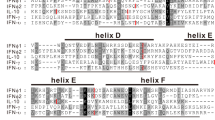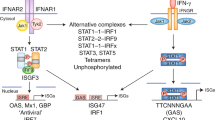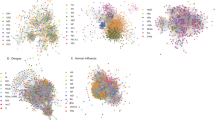Abstract
Interferons are proteins with antiviral, antitumour and immunomodulator activities, which are secreted in response to various inducers1. The interferons have been classified into two categories on the basis of their biological and physical properties. Type I interferons include fibroblast interferon (IFN-β)2,3 and the leukocyte family of interferons which is composed of at least 10 subspecies4–8. Each member of the type I interferons contains ∼165 amino acids, is acid-stable, and competes for the same receptors9; furthermore, identical amino acids occupy invariant positions in 23% of their amino acid sequences7. In contrast, type II interferon (IFN-γ) is produced in response to mitogens and antigenic stimuli10, contains ∼146 amino acid residues11, is not acid-stable, and displays no measurable binding to type I interferon receptors9. The nucleotide sequence of the cDNA coding for IFN-γ has recently been reported11, and no statistically significant sequence homology was detected between the deduced amino acid sequences of IFN-γ and any of the type I interferons11,12. To determine whether there might be structural similarities between IFN-γ and the type I interferons, we have conducted a predictive analysis of the secondary structure of these proteins13,14. IFN-γ as well as each of the type I interferons contain a segment with a high potential to form an amphiphilic α-helix of approximately the same length and hydrophobic/hydrophilic balance (Fig. 1). As we report here, the identification of these segments generates an alignment of sequences which reveals previously undetected sequence homologies among the type I and II interferons (Fig. 2). Thus, we propose that there is a common evolutionary ancestor for both type I and type II interferons.
This is a preview of subscription content, access via your institution
Access options
Subscribe to this journal
Receive 51 print issues and online access
$199.00 per year
only $3.90 per issue
Buy this article
- Purchase on Springer Link
- Instant access to full article PDF
Prices may be subject to local taxes which are calculated during checkout
Similar content being viewed by others
References
Stewart, W. E. II The Interferon System (Springer, New York, 1979).
Knight, E Jr. et al. Science 206, 525–526 (1980).
Taniguchi, T., Ohno, S., Fuji-Kuriyama, Y. & Muramatsu, M. Gene 10, 11–15 (1980).
Allen, G. & Fantes, K. H. Nature 287, 408–411 (1980).
Zoon, K. C. in The Biology of the Interferon System (eds deMaeyer, E., Galasso, G. & Schellekens, H.) 47–55 (Elsevier, Amsterdam, 1981).
Levy, W. P. et al. Proc. natn. Acad. Sci. U.S.A. 78, 6186–6190 (1981).
Goeddel, D. V. et al. Nature 290, 20–26 (1981).
Streuli, M., Nagata, S. & Weissman, C. Science 209, 1343–1347 (1980).
Branca, A. A. & Baglioni, C. Nature 294, 768–770 (1981).
Morris, A. G., Lin, Y-L. & Askonas, B. A. Nature 295, 150–152 (1982).
Gray, P. W. et al. Nature 295, 503–508 (1982).
Epstein, L. E. Nature 295, 453–454 (1982).
Edelstein, D., Kézdy, F. J., Scanu, A. M. & Shen, B. W. J. Lipid Res. 20, 143–153 (1979).
Chou, P. Y. & Fasman, G. D. Adv. Enzym. 47, 45–148 (1978).
Haber, J. E. & Koshland, D. E. Jr J. molec. Biol. 50, 617–639 (1970).
James, M. N. G., Delbaere, L. T. J. & Brayer, G. D. Can. J. Biochem. 56, 396–402 (1978).
Keim, P., Heinrikson, R. L. & Fitch, W. M. J. molec. Biol. 151, 179–197 (1981).
Matthews, B. W. Biochim. biophys. Acta 405, 442–451 (1975).
Shiffer, M. & Edmundson, A. B. Biophys. J. 7, 121–135 (1967).
Segrest, J. P., Jackson, R. L., Morrisett, J. D. & Gotto, A. M. Jr FEBS Lett. 38, 247–253 (1974).
Fukushima, D. et al. J. Am. chem. Soc. 101, 3703–3704 (1979).
Lim, V. I. J. molec. Biol. 88, 857–872 (1974).
Doolittle, R. F. Science 214, 149–214 (1981).
Zav'yalov, V. P. & Danesyuk, A. I. Immun. Lett. 4, 7–14 (1982).
Sternberg, J. E. & Cohen, F. E. Int. J. biol. Macromolec. 4, 137–144 (1982).
Gray, P. W. & Goeddel, D. V. Nature 298, 859–863 (1982).
Gilbert, W. Nature 271, 501 (1978).
Craik, C. S., Buchman, S. R. & Beychok, S. Proc. natn. Acad. Sci. U.S.A. 77, 1384–1388 (1980).
Author information
Authors and Affiliations
Rights and permissions
About this article
Cite this article
DeGrado, W., Wasserman, Z. & Chowdhry, V. Sequence and structural homologies among type I and type II interferons. Nature 300, 379–381 (1982). https://doi.org/10.1038/300379a0
Received:
Accepted:
Issue Date:
DOI: https://doi.org/10.1038/300379a0
This article is cited by
-
The cellular receptor of the alpha-beta interferons
Experientia (1989)
-
The presence of homologous regions between interferon sequences
Carlsberg Research Communications (1984)
Comments
By submitting a comment you agree to abide by our Terms and Community Guidelines. If you find something abusive or that does not comply with our terms or guidelines please flag it as inappropriate.



